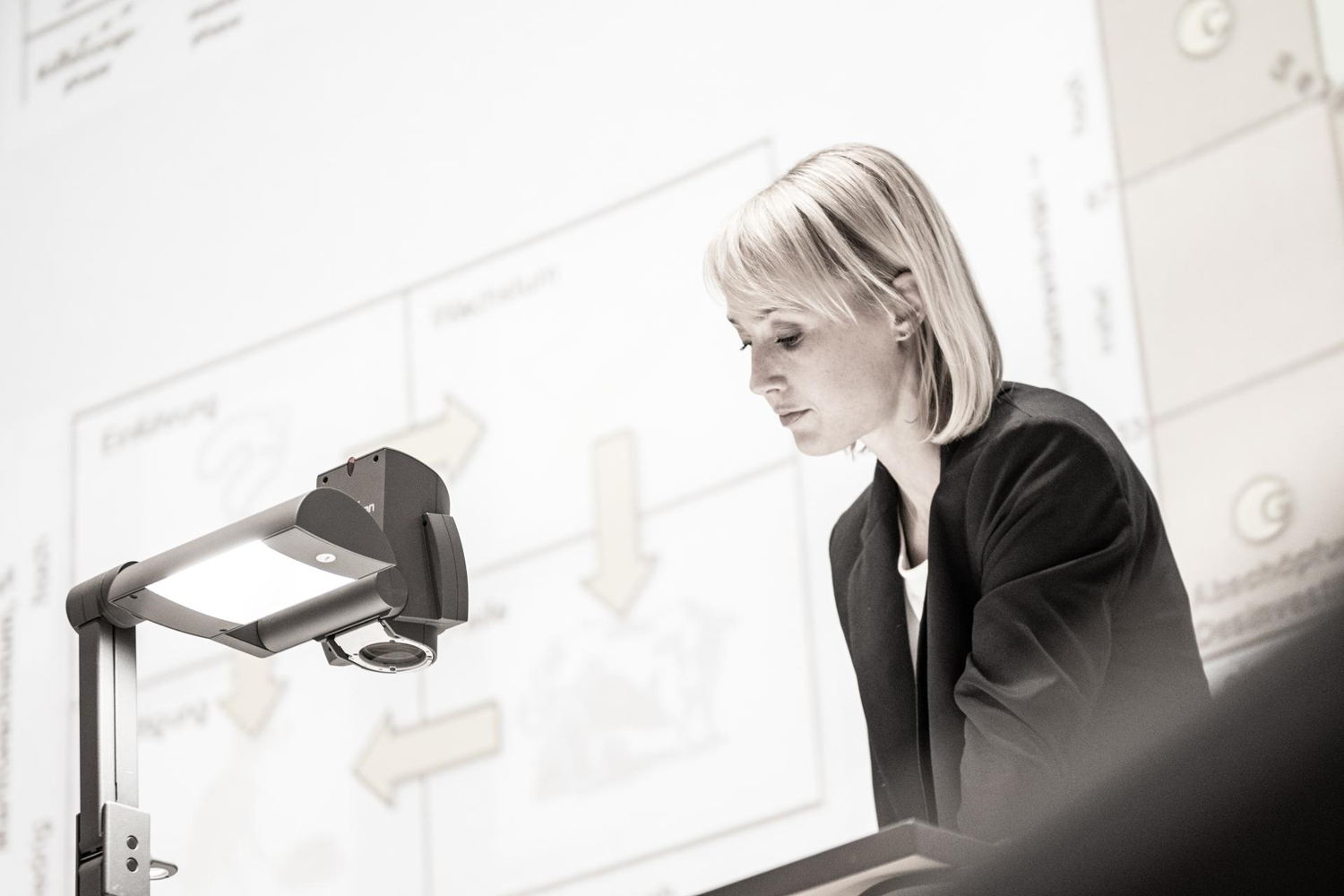The best presentation techniques for successful business meetings
November 26, 2019

And why throwing some PowerPoint slides onto the wall isn’t going to cut it
November 26, 2019 – Here comes the ugly truth: most presentations aren’t well prepared, don’t dive deep enough and won’t leave a lasting impression on their audience. To catch and retain the attention of our goldfish-brains prone to distractions, a presentation can’t just be good – it needs to be great. Certain presentation tricks and techniques will help you to deliver a presentation that sticks. They include but are not limited to the right structure, delivery, and choice of technology.
Which presentation techniques are there?
The term "presentation technique" is used for two different aspects of presentations. On the one hand, it refers to the technical aids (tools) used in a presentation. These include PowerPoint, other digital presentation media, and haptic aids such as flip charts.
On the other hand, presentation techniques are the techniques and tricks that make the presentation exciting and ensure that the message reaches the audience, is understood and stored. Both aspects will be discussed below, starting with the technical aids.
PowerPoint vs. new presentation technology
Out of twenty PowerPoint slides, people remember an average of four – immediately after the presentation (Reximedia, 2015). Of course, the number of slides that can be recalled isn’t what makes a good presentation. Instead, the aim should be to deliver information and messages with an impact that will be remembered by the listeners, but even here PowerPoint does not necessarily shine. A 2001 study shows that school classes taught with the help of PowerPoint presentations did not outperform their peer groups who received traditional lessons without PowerPoint.
New presentation techniques are innovative approaches to delivering messages that serve as an alternative to PowerPoint. Interestingly, oldies but goodies like whiteboards and flip charts found their way back into our hearts.
The biggest advantage of analogue presentation media such as flipcharts, whiteboards and overhead projectors is the collaborative feel. The audience can follow in real time as information is visualized. Information that isn’t already structured into bite-sized and well polished chunks and instead drawn up while the audience takes part in the process has better chances at being remembered. The disadvantage? These tools work best in meetings where all participants sit in the same room. Online meetings make it more difficult, but here too there are innovative approaches that stand out from PowerPoint. Prezi and Canva are among the most popular alternatives that differentiate themselves by offering expert design features.
You should consider the following new presentation techniques:
On-site meetings
- Flipchart
- Whiteboard
- Projector
- Props (that you can even hand around, for instance)
Online Meetings
There are now some great alternatives to PowerPoint that immediate attention from the audience because nobody else is using them. You can find a good overview here.
Which four presentation techniques should you master?
Visual support and variety
Visually showcasing the content of the presentation leads to more memorable meetings, and images work even better than words alone. Additionally, changing it up during your presentation will help the audience to keep their attention on you. If you just presented three slides with a mixture of words and images that had a red background, showing a slide with a video and a blue background will almost guarantee the new slide to be recalled particularly well.
But there’s a pitfall here: professionalism might get compromised when the presentation gets too wild and crazy. Be careful not to give an unprofessional impression by mixing up colors and sounds for pure entertainment, especially not in investor meetings or similarly serious affairs. If you’re presenting during an internal meeting or in front of the right customers, go for it! Always make sure that your level of “wow” is balanced with a competent performance.
No distractions
So the presentation should be visually stimulating, but not distracting? The message should be delivered eclectically, but still straight to the point? Presenting can be a tightrope walk. To ensure that the core message hits, you need to keep distractions to a minimum. Anything from disturbing noises to failing technology to visual distractions such as flamboyant clothing can cause distractions and direct your listeners’ attention away from what you’re saying.
So ask yourself the following question to span the arc and minimize distractions: What’s the story I want to tell with my presentation and which one to three core points need to stick with my audience?
Telling stories is how we keep people engaged. Stories are more easily remembered than naked facts and figures. As soon as you add an arc of tension to your presentation, you’ve won half the battle. While storytelling is very widely used in the States, it may not be as well received by all cultures. Weighing how expansively you’d like to deliver your story is essential. A German audience for instance will most likely get impatient if the if the connection to the matter gets fuzzy. Here, too, stories help, but they should be kept short and have a direct relation to the topic. In addition to one story, listeners can usually remember up to three core messages. Everything else is a distracting accessory and can be cut.

The right order
The Harvard Business Review pointed out in an article that the order of the presented facts has a great impact on how well a presentation is remembered. What is said at the beginning or end is most likely to be recalled later. The three most important messages should be made clear right at the beginning. The entire middle part of the presentation should be used to explain why these three things are so important. At the end you should summarize again.
An example: You lead a sales meeting and want to make it clear to your team that
- more customer visits have led to more revenue
- but only if these meetings were scheduled following at least one online meeting for preparation.
- Therefore, a new process is implemented that only emburses the salesperson for customer visits that were preceded by a preparation meeting.
Do not start with an anecdote, an example of a particularly successful team member or a slide with graphs and numbers, but summarize exactly the points above. Once you have brought them across to the team, you may add colorful graphs, spotlight a particularly successful salesperson, and ask the team for concerns and opinions. That would be the most effective structure.
Self-confidence and assertiveness
This is where our caveman instincts come into play. Nobody wants to follow an insecure leader, nobody wants to listen to vague instructions, nobody wants to remember unreliable information. Therefore, you have to give your presentation with a certain level of self-confidence. This works best if you are well prepared and have practised your presentation in advance. A lot. A few preparation tips:
- Hold the presentation in front of colleagues, friends, or a partner
- Record yourself on video and critique your own performance – nobody will judge you more harshly than yourself
- Set aside some time right before the presentation to prepare mentally (by using visualization techniques, “power poses”, breathing exercises, or whatever else helps you)
Paradoxically, listeners remember flawless presentations less well. The audience benefits from having to do some of the work itself. Have your listeners answer question, give estimations, participate in discussions, and uncover contradictions. If you suddenly lose your train of thought, see it as an opportunity. Let the audience step in!
One last tip for an effective business presentation
Don't obsess. If you try too hard and use the fanciest new tool for creating your next presentation, relying on constant variety and new rhetoric tricks, you will easily overwhelm both the audience and yourself. You have something important to say... don't you? Many business meetings are as boring as they are because the information could have been sent in an email. Neither the presenter nor the meeting participants find the topics particularly exciting and so everyone is a bit annoyed at the end. Even the most fantastic whiteboard tricks couldn't have changed that.
So the most important thing for your next meeting should be the question: What do I want to convey and why? If you have a clear answer to that question, you'll rock it!




